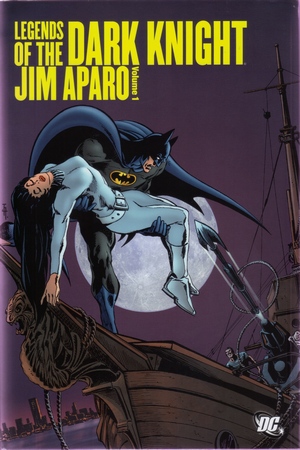Legends of the Dark Knight: Jim Aparo Volume 1 Review
By Leroy Douresseaux
April 25, 2012 - 12:35
DC Comics
Writer(s): Bob Haney
Penciller(s): Jim Aparo
Inker(s): Jim Aparo
Cover Artist(s): Jim Aparo, Alan Passalaqua
ISBN: 978-1-4012-3375-4
$49.99 US, $57.00 CAN, 360pp, B&W, hardcover
 |
| Legends of the Dark Knight: Jim Aparo Volume 1 cover image |
Now, the focus is on Jim Aparo, beginning with Legends of the Dark Knight: Jim Aparo Volume 1. This hardcover, 360-page book collects 23 issues of The Brave and the Bold drawn by Aparo and written by Bob Haney, one of the most influential and important writers in the history of DC Comics. Debuting in 1955, The Brave and the Bold featured the debut of the Justice League of America (#28, February-March 1960) and of what would become the Teen Titans (#54, July 1964).
Beginning with its 74th issue, The Brave and the Bold became a Batman team-up title. Jim Aparo, who at the time had only been at DC Comics a few years, was the fill-in artist for The Brave and the Bold #98. Beginning with #100, he became the regular artist and from 1971 to end of The Brave and the Bold in 1983, Aparo was the series’ regular artist.
Over a 30-year period, Aparo was probably the most prolific artist on the Batman line of comic books, but during that time, other Batman artists, like Neal Adams, Marshall Rogers, and Frank Miller, received more attention and critical acclaim. Aparo was clearly influenced by Neal Adams, who was his contemporary. Still, Aparo had his own style and was able to stand apart and also influence later Batman comic book artists, including, by my estimation, Norm Breyfogle, Alan Davis, and Bruce Timm.
Unlike the muscular, pumped-up Batman that is familiar to today’s readers or the classic line, cleanly-designed Batman of the Golden and Silver Ages, Aparo’s Batman is a lean, muscular figure. Aparo gives Batman the rangy and nimble physique of a natural athlete. He poses Batman in a way that makes him seem like a normal person, but also presents him in a classical fashion, as if Batman were posing before a figure drawing class. Aparo also gives Deadman the natural/classical ideal treatment during the character’s appearance and team-up with Batman. (The Brave and the Bold #104, “Second Chance for a Deadman”).
Aparo’s Batman is unmistakably human. Of course, Bob Haney gets credit as the writer of the stories reprinted here, but comics is a graphics medium in which a storyteller draws the story. Aparo’s Batman comes across as a tangible person. He is vulnerable and fragile, contemplative and thoughtful, stalwart and steady, brave and bold, and is as surprisingly emotional as he is consistently rational (as a detective).
Whoever made Aparo the regular artist on The Brave and the Bold made the perfect choice. Aparo had the ability to adapt Batman’s emotions, moods, and appearance for wildly differing scenarios. That also made him the perfect artist to draw Batman stories which paired him with other characters that were like him, only somewhat like him, and not like him at all.
In the story “The Commune of Defiance,” (The Brave and the Bold #102), Batman and the Teen Titans unite to help a group of young people save their blighted neighborhood. In this story, Batman is a father figure who not only discourages the young radicals’ propensity towards violence, but also encourages them to work towards their goal. Here, Batman the masked avenger becomes Batman the defender and people’s champ. He believes that if someone saves these young people’s neighborhood for them, it will mean much less than if they did the work to save and rebuild their homes. Today, Batman would be called a “thug hugger” for his stance in this story. So it is safe to say that this Batman, who bucks the police and political power in Gotham to help “young criminals” save their neighborhood, will never been seen again.
What we as readers and people who appreciate the medium lost when Jim Aparo retired was a storyteller who recognized what is best about these superheroes. They are not gods and figures of some new mythology. They are like us, but better; they are idealized versions of what we’d like to be. Our good sense and perhaps, some physical revulsion might keep us from jumping into the middle of an inferno to save a life. A superhero like Batman is someone like us – someone we want to be – who will indeed dive into the inferno. This is Aparo’s Batman.
I don’t mean to do a disservice to Bob Haney, a master storyteller who could do in a single issue what someone apparently can’t do in six issues of Justice League – tell a complete story. However, Legends of the Dark Knight: Jim Aparo Volume 1 is about Jim Aparo. I’ve long thought this, and now, I can unleash this thought. Jim Aparo, at this point in time, is the greatest Batman artist in the history of comic books.
A+
Related Articles:
Dark Knight III: The Master Race #9 comics review
Dark Knight III: The Master Race #8 comics review
Dark Knight III: The Master Race #7 comics review
Dark Knight III: The Master Race #6 comics review
Missed Call #2: The Dark Knight vs. The Dark Knight
Batman - The Dark Knight Rises Miracle Action Figure
Batman The Dark Knight Returns Part 2
Batman The Dark Knight Returns Part 1
The Dark Knight Returns Part 2 on DVD/Blu-Ray Today
The Binquirer, August 9 Edition: New Legends of the Dark Knight lineups, Ben Affleck and Justice League, and much more!
